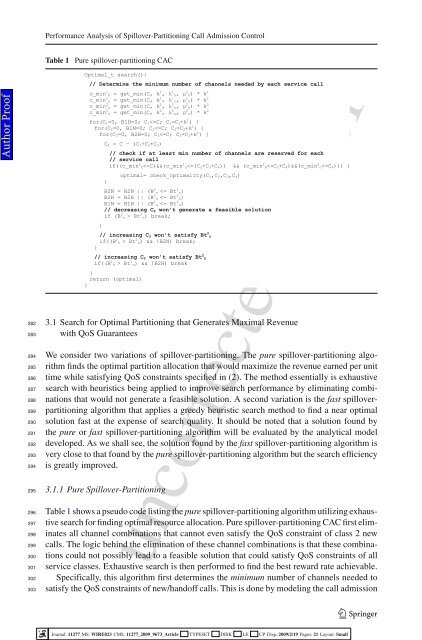Dear Author, Here are the proofs of your article. ⢠You can submit ...
Dear Author, Here are the proofs of your article. ⢠You can submit ...
Dear Author, Here are the proofs of your article. ⢠You can submit ...
- No tags were found...
Create successful ePaper yourself
Turn your PDF publications into a flip-book with our unique Google optimized e-Paper software.
Performance Analysis <strong>of</strong> Spillover-Partitioning Call Admission ControlTable 1 Pure spillover-partitioning CAC<strong>Author</strong> Pro<strong>of</strong>2822832842852862872882892902912922932942952962972982993003013023033.1 Search for Optimal Partitioning that Generates Maximal Revenuewith QoS GuaranteesWe consider two variations <strong>of</strong> spillover-partitioning. The pure spillover-partitioning algorithmfinds <strong>the</strong> optimal partition allocation that would maximize <strong>the</strong> revenue earned per unittime while satisfying QoS constraints specified in (2). The method essentially is exhaustivesearch with heuristics being applied to improve search performance by eliminating combinationsthat would not generate a feasible solution. A second variation is <strong>the</strong> fast spilloverpartitioningalgorithm that applies a greedy heuristic search method to find a near optimalsolution fast at <strong>the</strong> expense <strong>of</strong> search quality. It should be noted that a solution found by<strong>the</strong> pure or fast spillover-partitioning algorithm will be evaluated by <strong>the</strong> analytical modeldeveloped. As we shall see, <strong>the</strong> solution found by <strong>the</strong> fast spillover-partitioning algorithm isvery close to that found by <strong>the</strong> pure spillover-partitioning algorithm but <strong>the</strong> search efficiencyis greatly improved.3.1.1 Pure Spillover-PartitioningTable 1 shows a pseudo code listing <strong>the</strong> pure spillover-partitioning algorithm utilizing exhaustivesearch for finding optimal resource allocation. Pure spillover-partitioning CAC first eliminatesall channel combinations that <strong>can</strong>not even satisfy <strong>the</strong> QoS constraint <strong>of</strong> class 2 newcalls. The logic behind <strong>the</strong> elimination <strong>of</strong> <strong>the</strong>se channel combinations is that <strong>the</strong>se combinationscould not possibly lead to a feasible solution that could satisfy QoS constraints <strong>of</strong> allservice classes. Exhaustive search is <strong>the</strong>n performed to find <strong>the</strong> best reward rate achievable.Specifically, this algorithm first determines <strong>the</strong> minimum number <strong>of</strong> channels needed tosatisfy <strong>the</strong> QoS constraints <strong>of</strong> new/hand<strong>of</strong>f calls. This is done by modeling <strong>the</strong> call admissionuncorrected pro<strong>of</strong>123Journal: 11277 MS: WIRE823 CMS: 11277_2009_9673_Article TYPESET DISK LE CP Disp.:2009/2/19 Pages: 21 Layout: Small
















